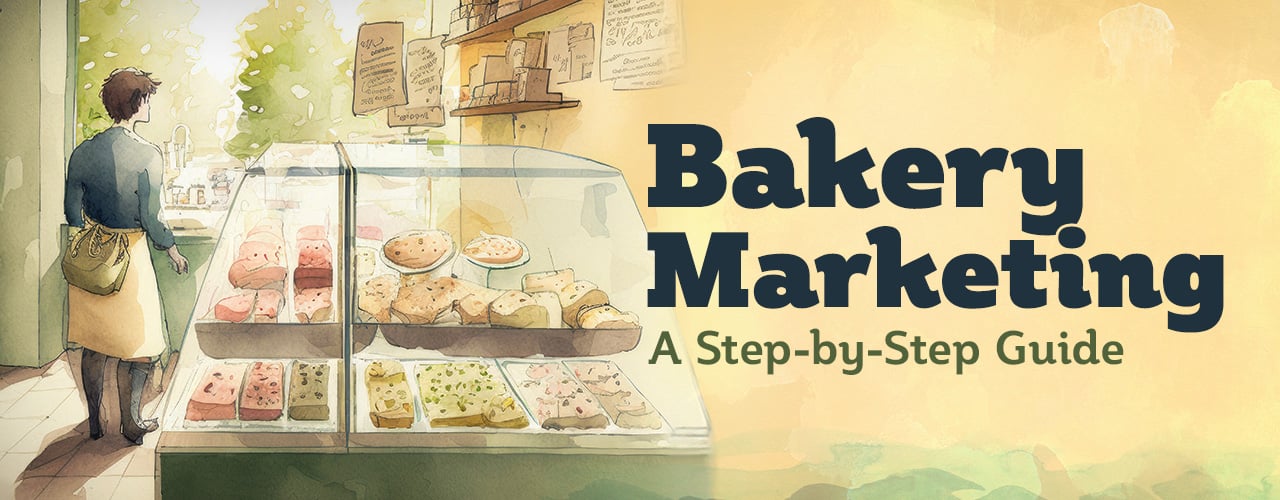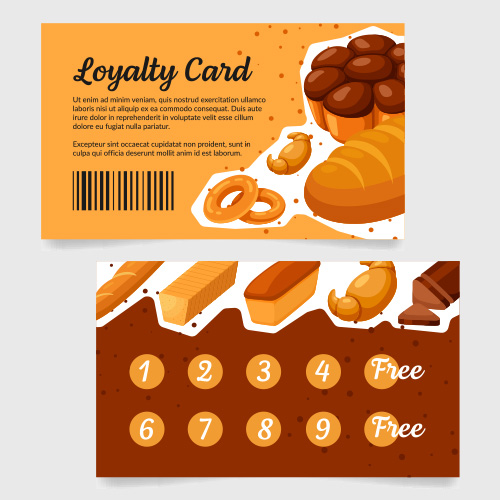
To make your new bakery successful, it’s important to define your target market and put an actionable plan in place to reach them. Developing a well-researched bakery marketing plan allows you to pick a location for your business in the heart of your ideal customer base and create content that resonates with them. Not just important for reaching customers, you must include market research and a bakery market analysis in your business plan to show future investors that your business has the potential for success. We’ve created a step-by-step guide to marketing your bakery so you can reach your sales goals.
Bakery Marketing Plan
From the action steps you should take before your grand opening to marketing tactics even well-established bakeries should use, we walk you through each step of implementing a bakery marketing plan.
1. Conduct Market Research

When starting a bakery, it is important to do market research to determine which products are in high demand. This can be done by collecting primary and secondary data. Primary data is obtained by directly interacting with potential customers and studying the competition. One way to gather primary data is by offering your products on a smaller scale, like at a farmer's market or through a ghost kitchen, to get customer feedback before opening a physical store. Secondary research involves gathering data from external sources like government censuses and trade associations. This information can provide valuable demographic data which will be the foundation of your next step: identifying your target market.
2. Define Your Target Market and Write a Market Analysis
Defining your bakery's target market is crucial for success. It involves identifying the specific customers or businesses to whom you want to sell your goods. By understanding your target market, you can determine what type of bakery you want to open and tailor your offerings accordingly.
It is important to be as specific as possible when defining your market, considering factors such as the type of customers you want to serve and the geographic area you want to target. You must decide if you will primarily sell from a storefront or sell your sweets online. You must also decide if you will sell to customers directly or to other businesses, like diners, restaurants, and cafes.
3. Set Your Marketing Goals

Marketing goals are essential for achieving the sales goals outlined in your bakery's business plan. By setting these goals, you create a benchmark to evaluate your future performance. This evaluation helps you determine the effectiveness of your strategies and whether adjustments are necessary. Consider the following questions when establishing your marketing goals:
- How many hours per month do you plan to dedicate to marketing your bakery?
- Which social media platforms are most effective in reaching your target market?
- How many followers do you want to have on your social media channels by the end of the year?
- What is your estimated monthly sales volume, and what will be the average revenue generated from those transactions?
- What percentage of the local bakery market do you intend to capture by the end of the first, second, and fifth year of opening?
4. Market to Your Ideal Customer Base
With your goal in mind and your preliminary research as your guide, create a marketing plan that will reach your ideal customer base. If you run a trendy bakery in a college town, TikTok and Instagram marketing are essential. Alternatively, if you produce wedding cakes, pay for targeted digital ads to go out to newly engaged couples and wedding planners.
Depending on your ideal customer base, you can alter your price points, offerings, location, and overall aesthetic. Consider coming up with imaginary profiles to bring your ideal customer to life, providing them with the specific ages, gender identities, income levels, and professions of the patrons you hope to attract.
5. Promote What Differentiates Your Product

To attract customers and stand out in a competitive market, it is important to establish a strong presence within your niche. Learn popular baking terms and highlight the unique qualities and features of your products to effectively market what sets them apart. For example, if your bakery specializes in using healthy ingredients, promote your products’ nutritional value and the positive impact they can have to attract health-conscious customers.
Offering gluten-free options is another way to differentiate yourself, as more people are following gluten-free diets. Promote your gluten-free offerings in your signage, bakery name, and on social media platforms to attract customers seeking these options. Incorporating unique, global fusion flavors into your products can also attract customers. By offering a diverse range of flavors inspired by different cuisines, you can provide a unique and memorable experience. For example, bright purple ube treats make a splash on social media, as do trendy mochi donuts, drawing customers to your business for an experience they can’t easily find elsewhere.
Back to Top6. Choose Print Marketing Materials
While the world has gone digital, you’ll still need some print marketing materials to reach your target market. Don’t be afraid to ask customers how they heard about your business and use this information to determine how successful your print marketing campaign is. Below are a few common print marketing materials to consider.
- Brochures and Flyers - These are relatively easy and inexpensive to produce. Outline your menu and mission statement to give community members an overview of your business. If you’re a health-oriented bakery, place your flyers in local gyms. If you operate near a college campus, advertise your bakery on a college bulletin board.
- Postcards - If you have access to local mailing addresses, consider sending postcards out to invite customers into your bakery. This is a good method for alerting community members about your grand opening. People aren’t used to getting mail other than bills anymore, so this is a great personal touch that can build brand loyalty for your small business.
- Business cards - Because they’re small and portable, you should keep business cards available to hand out. If you’re doing business-to-business sales, these are especially important.
- Newspaper Ads - These can be useful for targeting an older demographic that may not be on social media. If you place an advertisement in a local paper, keep it circulating long enough to measure its performance.
- Niche Local Magazines - If there is a local magazine that caters to your niche, putting an ad for your business is a great marketing strategy. Examples would be a local wedding magazine for a wedding cake bakery, a vegan magazine for a plant-based bakery, or a local culture magazine for a trendy bakery that offers community events and showcases local art.
7. Use Social Media

Creating social media pages for your business is perhaps the most valuable piece of your marketing strategy. Social media allows customers to get to know your business’s personality, see photos of your products, hear about your specials/monthly flavors, and stay up to date with any updates, which helps them form a connection with your bakery. Social media can even be used as your main website until you can establish your own domain. Get the most out of your social media pages, upload your menus, and actively reply to chats.
Use your social media pages to showcase your baked goods with eye-catching food photography pictures. Help prospective customers engage with the day-to-day activities of your bakeshop by creating behind-the-scenes TikTok videos and sharing daily updates on your Instagram stories. Customers want to see you mixing dough, frosting cupcakes, and arranging the bakery case. This insight into the baking process is what made the open kitchen concept so popular with bakeries, and social media allows customers to have that experience remotely.
8. Create a Search Engine Optimized Website
You can have an engaging, easy-to-navigate website, but that won’t do you much good if no one can find it. This is where SEO comes in. SEO stands for search engine optimization, and it uses various strategies to make websites stand out on Google.
Implementing basic SEO strategies can have a big impact on the traffic to your website, which can lead to more traffic in your brick-and-mortar store. For example, if someone searches for “cupcake bakeries in (your city),” you want your cupcake bakery to show up first on the page. Optimizing your website using basic SEO techniques will also help you show up on important page listings like Yelp and Google Maps when customers search for baked goods in your area.
9. Create a Loyalty Program

Once you have established a steady flow of customers to your bakery, you must focus on retaining them. One effective strategy is to implement a loyalty program that demonstrates appreciation for your customers. You can offer a loyalty card or use a system that tracks visits through the customer's phone number. By rewarding customers with a free item or discount after a certain number of visits, you incentivize them to return to your bakery.
Asking customers to complete an online survey after their visit, and offering a reward for doing so, can provide valuable feedback and show that their opinions are valued. This also allows customers to provide their opinions anonymously, enabling your bakery to receive valuable critiques. Pay attention to recurring complaints or suggestions and let customers know that their voices are being heard.
10. Focus on Community Outreach
You must establish a presence in your local community, so its residents view your bakery as an integral part of the neighborhood. There are many ways to get involved with your community.
Consider selling your products at the farmer's market, organizing fundraisers for local charities, or contributing goods to events and fundraisers. Any potential loss in profits or donations can be offset by the positive brand image you will build among community members. Back to TopA well-executed marketing campaign is essential for the success of your bakery. By understanding your ideal target market, developing a strong brand identity, creating engaging content, and connecting with your local community, you can effectively position your bakery in the market and attract customers for years to come. Remember that marketing is an ongoing process. Continuously monitor and analyze the performance of your marketing efforts to identify what strategies are most effective in reaching and engaging your target market. Stay up to date with current industry trends and adapt your marketing strategies accordingly to ensure your bakery remains relevant and appealing to customers.





